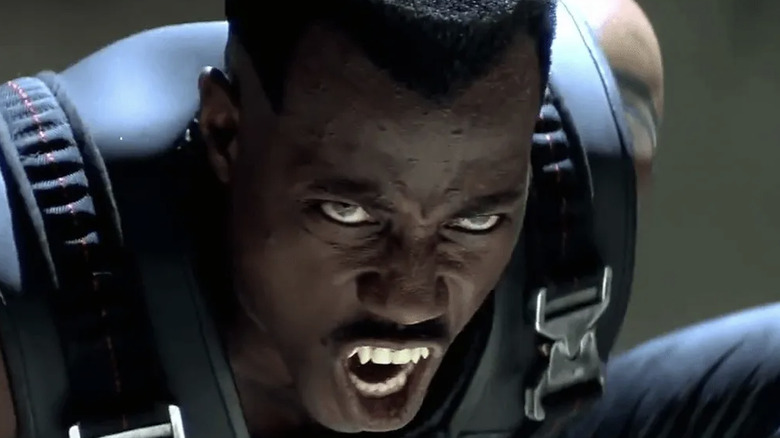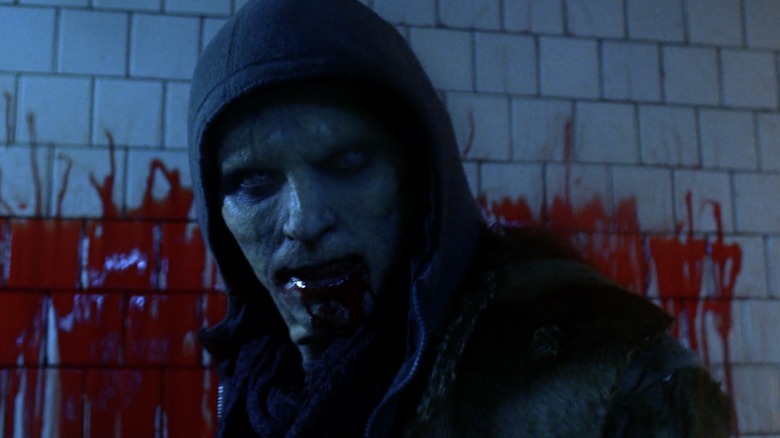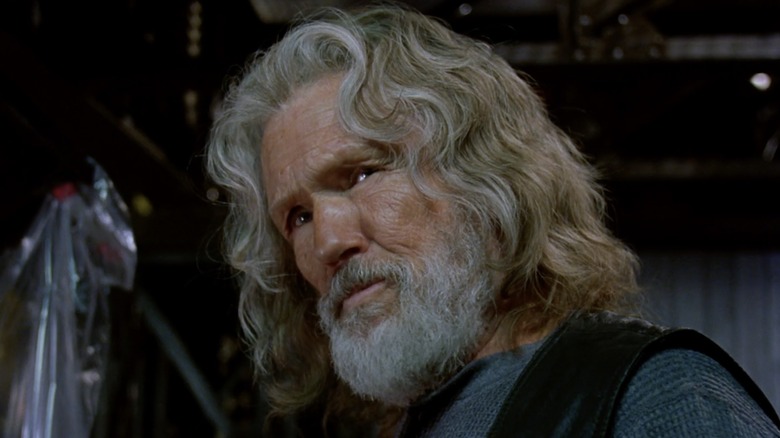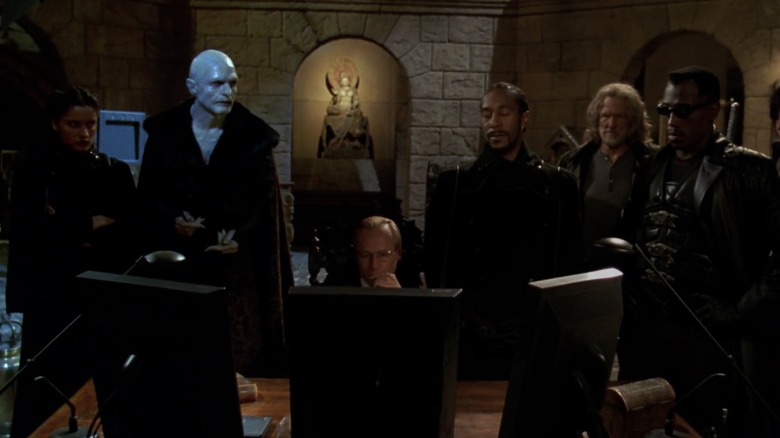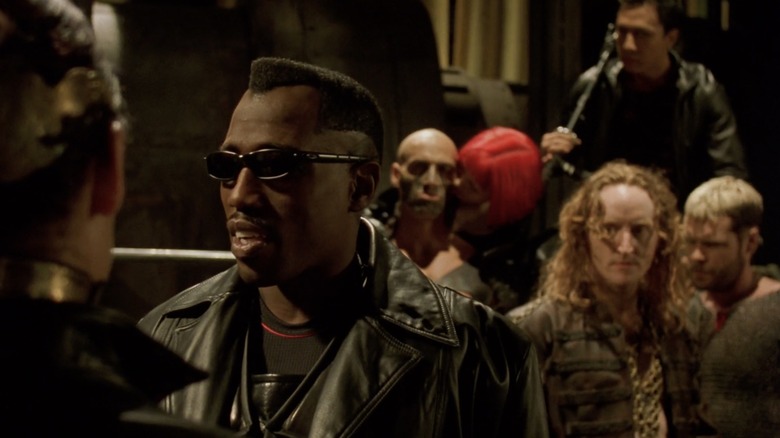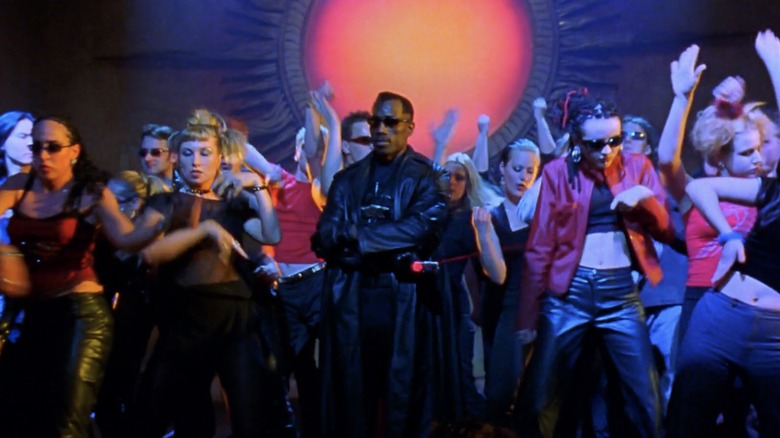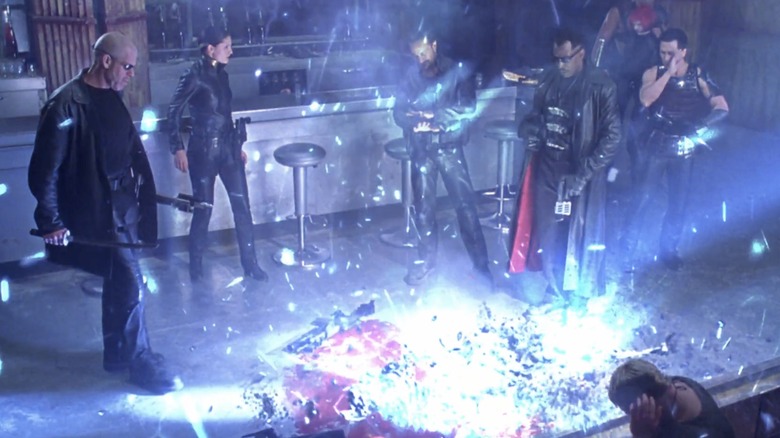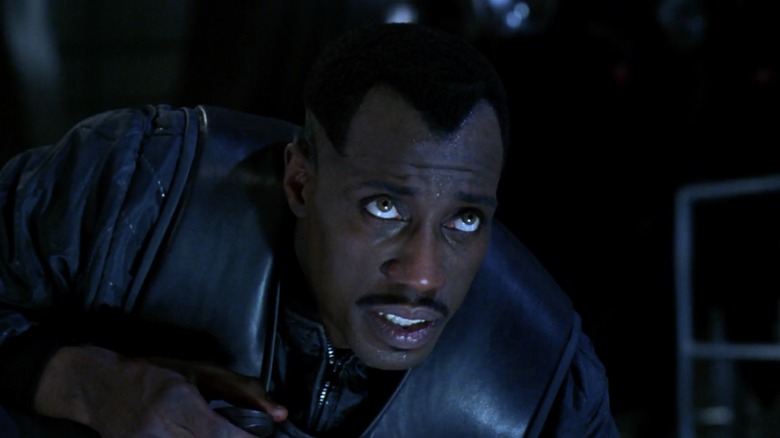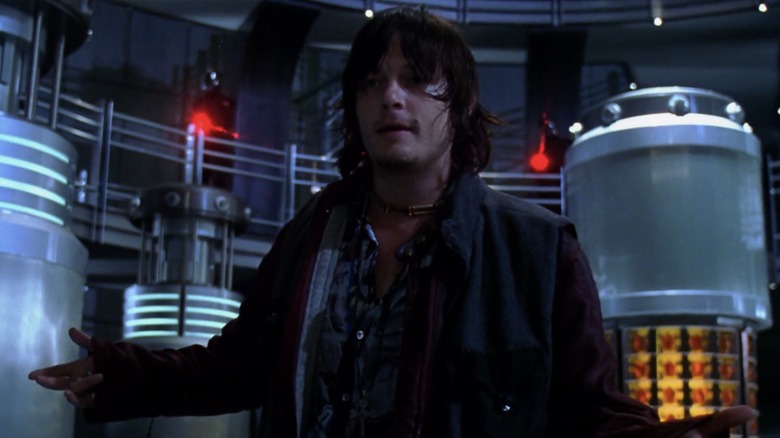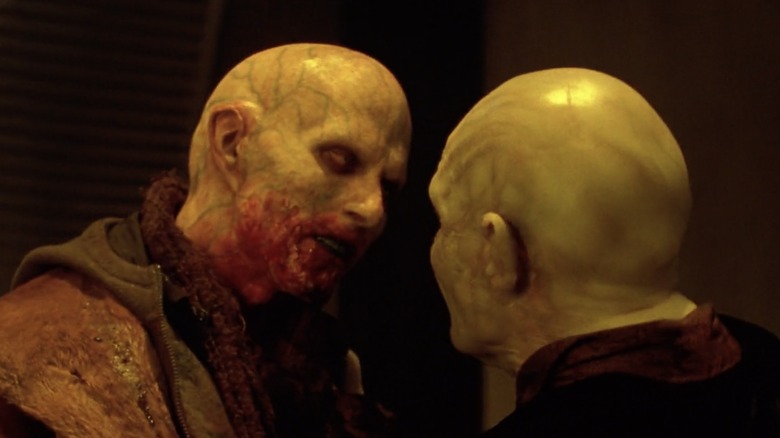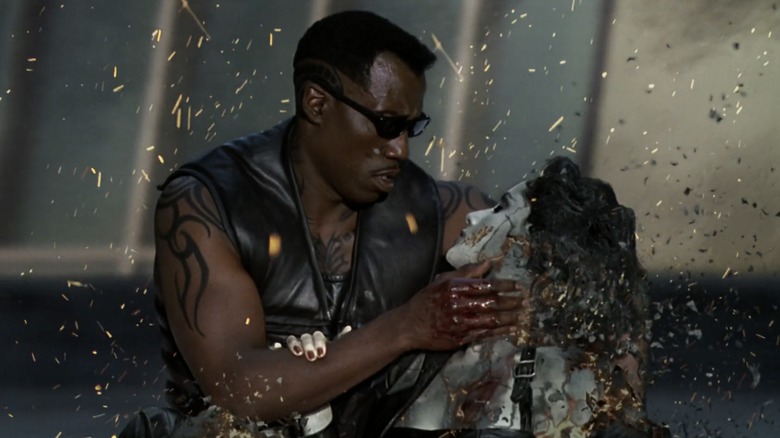The Ending Of Blade II Explained
If Iron Man was the foundation for the initial success of the Marvel Universe, the "Blade" trilogy was the firmly packed soil upon which that foundation rests. The 1990's "Blade" series was one of the first glimpses of how lucrative a Marvel comic book property could potentially be when executed faithfully. The unexpected success of the first film screamed for a sequel, but it would still take four years to put the pieces together; sure enough, it was a hit as well, powering an eventual trilogy.
The crew assembled to create "Blade II" is the stuff of comic-book-fantasy fever dreams. Wesley Snipes was brought back as the vampire dicer, of course. A then-up-and-coming Guillermo Del Toro (he had made "Cronos" and "The Devil's Backbone" at that point, but was still years away from classics like "The Shape of Water" and "Pan's Labyrinth") was tapped to direct, working for the first time with frequent collaborator Ron Perlman. Also involved was Norman Reedus, years before his breakout in the comic book adaptation of "Walking Dead".
Tony Curran (as Priest) would go on to star in another vampire series ("Underworld Evolution"), Donnie Yen (who played Snowman) would later have his own starring role in the "Ip Man" series, and writer David S. Goyer would go on to pen Batman and Terminator movies and direct several films, including 2004's "Blade Trinity." With all that budding talent, it's no wonder that "Blade II" exists today as an ambitious flick well worth remembering.
Perhaps the most memorable aspect of the film, however, is its conclusion. So, let's take a look at the dark, twisted "Blade II" ending that still cuts deeply.
Upping the ante
When audiences last left Blade, he had just defeated a blood god seeking to rule all of humanity. Raising the stakes even higher is tough, especially when you need to aim for the heart. What better way to elevate the danger than to introduce a new type of villain that causes vampires to quake in their leather pants? Enter Jared Nomak (Luke Goss), a new breed of bloodsucking fury. This thirsty villain comes with more than just a set of fangs — his entire lower mandible flaps open to reveal a sandworm for a tongue, which can drain hemoglobin from its victims.
Nomak is the original carrier for the Reaper virus — a highly infectious strain that transforms not only humans, but vampires as well. These crazed creatures will drain the blood from anything they can get their mandibles on, and at record pace. The reapers' accelerated metabolism means they don't just need to feed every now and again (like vampires), but every few hours, and everything they feed on turns into another reaper. It is the beginning of a pandemic that will decimate the world, if Blade can't stop it.
Getting the crew back together
Story, plot and character development are all fine and dandy, but "Blade" audiences want to watch the titular hero kick some vampire butt. Those longing for garlic injections, acid-etched swords with booby trapped hilts, and silver-loaded pistols that double as daggers will find themselves satiated, with Del Toro flair that includes the glowing embers of vampire ashes dancing across the screen.
Blade's first dance with vampiric nasties involves a hearty mix of slaying and motorcycles, but is all done with purpose.
The hero's primary objective in the opening moments of "Blade II" is to track down his old mentor, Whistler (Kris Kristofferson). The first film made it seem as though he had died after being tortured by Deacon Frost (Stephen Dorff), but since vampires are huge jerks, they turned Whistler into one of them and tortured him for two years. The grouchy vet is taken back to Blade's new safehouse, where he discovers that a new weapon master (Scud, played by Norman Reedus) has taken over his workshop. Whistler isn't too pleased with what the stoner mechanic has done to his life's work, but before they can resort to fisticuffs more pressing matters arise.
An unexpected proposition
Rather than approach the vampire hunting gang with a white flag or perhaps a nice Edible Arrangement, the vampires decide to sneak into the workshop clad in high tech spy gear and show off their cirque du soleil skills across the building's rafters. These crafty bloodsuckers are seeking out Blade and his cohorts for help, but first they need to have a sword fight in front of a wall of stage lights that would make Beyonce yearn for their production budget.
When the tension in the room is less palpable, a healthy exposition is managed. The vampires were sent by a vampire overlord named Eli Damaskinos (Thomas Kretschmann), an undead Hefner-type who looks like he has a picture of Emperor Palpatine hanging over his bed. One of the vampires sent to deliver the message is Damaskinos' own daughter, Nyssa (Leonor Varela). They seek an alliance with Blade so they can stop the spread of the Reaper virus. First thought would be to just let Nomak and his minions suck all the vampires dry, but the reality of the situation is they would then turn on humans as a food source soon. Whistler, Blade, and Scud reluctantly agree to team up with the vampires.
The enemy of my enemy
Leading a pack of bloodthirsty warriors who despise your presence in their ranks is a tough task. If anyone is up to the challenge, however, it's The Daywalker.
Much like stepping into the prison yard, it is best to establish dominance by putting the big dog in his place right out of the gate. In the case of the reaper hunting crew, that would be Dieter Reinhardt (played by Ron Perlman). So, when the Aryan vamp throws shade at Blade, he responds by fastening an explosive device to the back of Reinhardt's skull. Now that assurances have been established, it's time to get back to hunting those reaper thingies.
Blade applies his years of vampire-hunting skills to devise a plan to track down Nomak and his reaper brethren. Since the reapers have an insatiable hankering for vampire blood, they need to infiltrate a gathering of vampires — who are well-established lovers of dancing under strobe lights. With Nyssa and the other vamps in tow, Blade gets the inside scoop on exactly where vampires like to shimmy their lustful hearts out. The first stop for this reaper hunting group will be jumping around at a nightclub named House of Pain.
Into the lion's den
It wouldn't be much of an adventure if things went according to plan.
The House of Pain is indeed a nightclub packed with party vamps looking for a good time, and there are indeed reapers lurking about, just as Blade predicted. What the gang didn't count on is the sheer ferocity of these thirsty suckers. Multiple members of the hunting party succumb to the reapers, but it's not a total loss: The ordeal supplies Blade with a much needed chunk of information.
Blade is well aware that the vampires will cross him, likely forming an alliance to stop Nomak's bloodlust, but still mortal enemies. So, throughout all these encounters, Blade keeps a sunglass-shaded eye out. While the events at House of Pain don't appear to be very beneficial, the team learns a great deal of important information, like that the transformation into a reaper can occur in as little as twenty minutes (as opposed to a couple days for vampires). Blade also deduces that there is some sort of relationship between Nomak and Nyssa. The audience also learns, quite clearly, that Whistler isn't fond of Scud.
The silver lining
Whistler isn't one to mince words, and abandoning his post and leaving Scud to grapple with several reapers is a shady maneuver. Given that Whistler just spent two years behind enemy lines, it seems possible that the vampire hunting patriarch has been afflicted with Stockholm Syndrome and seeks to rejoin his captures. There is nothing to fear, however; his abandonment has better reasons than first indicated.
One of the reapers lagged behind the rest of its group while descending into the sewers, so Whistler is able to capture him. Examining this little bugger gives Blade loads of information that will help his quest. The reaper's hearts are encased in a thick layer of bone, which makes staking them nearly impossible; the only way to reach its vital organ is through their side. The location Whistler found this reaper at also gives Blade an idea of where to attack next. While it's not clear exactly why he chooses to descend into the sewers during the daytime, best guess is he just doesn't like his vampire partnership and doesn't care about what happens to them.
Trekking through the mucky muck
In the world of "Blade," harnessing the power of the sun is a power to be desired, particularly by a pothead named Scud in a dingy warehouse. So, the scrappy mechanic develops an ultraviolet bomb capable of reducing both vampire and reaper to ash. It is among the weapons he supplies Blade with before they trek into the sewers. Around this time, Nyssa and Blade are developing a friendly rapport. Blade is a guarded individual, even more so with vampires. His willingness to begin trusting Nyssa helps bridge a huge gap, and will help in the end — but not before Blade severely regrets it.
Once down in the sewers, Blade detonates a massive cache of UV bombs, to obliterate all the reapers in the immediate area. The reapers aren't the only ones who suffer casualties, as most of the vampire hunting crew also meet their ends in the sewers. A moment of trust is established when Blade allows Nyssa to drink his blood, in order to save her life. It is in this moment that the vampires choose to turn on Blade — and what better way to reveal their true nature than to have a lawyer deliver the bad news.
Relationships are tricky
Blade has some trust issues; at this point in "Blade II," the audience learns why. The vampires decide that since a large chunk of reapers have been killed, their alliance with Blade no longer serves its purpose. Nomak may still be running around draining vampires of their limited complexion, but that's nothing compared to wrangling the daywalker. After being incapacitated and dragged back to the vamp headquarters, Blade wakes up in a blood chamber filled with guards with laser pointers. All of his weaponry has been taken from him, save the detonator for the bomb he attached to Reinhardt's skull.
The bomb on Reinhardt has served as a way for Blade to maintain control of the little reaper hunter squad. Turns out it was even more than that, because attempting to detonate the device helps reveal Scud's true nature. The little skeez is actually a familiar for Damaskinos and has been the vampire's inside man.
Blade is not pleased, and Scud quickly learns what it means to be on the opposing end. The cranial explosive device that Scud believes he had disarmed is actually quite active — the detonation reduces his mortal coil to a mere poof of crimson stardust.
Saw that one coming
Sex and betrayal are always a good source of cinematic drama. So, vampires pulling a fast one is a double whammy. Given Blade's history with the nocturnal predators, it's safe to say he had a feeling they'd cross him. All the relationship squabbles up to this point become crucial elements in the climax of "Blade II," as the vampires become content that the location of their clubhouse is a secret; Blade, however, has been planning on how to deal with this inevitable betrayal for some time. What better way to turn the tables than to send the vampire's enemy right to their doorstep?
Blade has informed Nomak of the lair's location, and the angry variant arrives just in the nick of time. While Reinhardt and the gang are snickering about how awesome they are, Nomak charges the compound and begins draining the life from every security guard he can grab. It's around this time that the viewer learns exactly why he seems so angry about existing. Damaskinos is actually his father, and the reaper virus was accidentally created by vampires while they were trying to turn themselves into Daywalkers.
It's hard to trust anyone nowadays
The vampire overlord, Damaskinos, is defined by his hubris. This translucent bloodsucker thought he could have his cake and drink it too.
What he failed to take into account, however, is that Blade isn't the only one who hates being manipulated and used as a pawn. Damaskinos' daughter, Nyssa, decides to pull off her own brand of betrayal at the 11th hour, growing a conscience. Rather than allow her father to escape the clutches of Nomak and his reaper madness, she locks him in the compound and forces dad to face the music.
The conclusion to "Blade II" is all about the web of mistrust that has been constructed throughout the film. Blade's relationship with Nyssa helped turn her against her father, essentially handing Nomak a nice little vindictive snack. The messy business back at House of Pain also helped gather the info necessary for Blade to defeat Nomak himself. Rather than trying to drive a stake through the creature's solid bone chest, he sneaks a dagger in through his side, spearing Nomak's heart.
While it's hard to claim a "happy" ending since before Nomak dies he takes a hearty bite out of his sister, in the final moments of "Blade II" the pureblood princess is finally able to view a sunrise for the first (and last) time. She is the final victim of the reaper virus, so letting her dissipate into ash is necessary. It's best not to worry about the mountain of security guard corpses Nomak left behind. This is about as feel good as a "Blade" movie gets.
